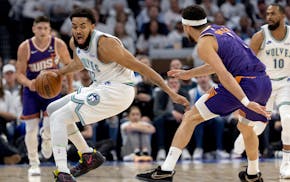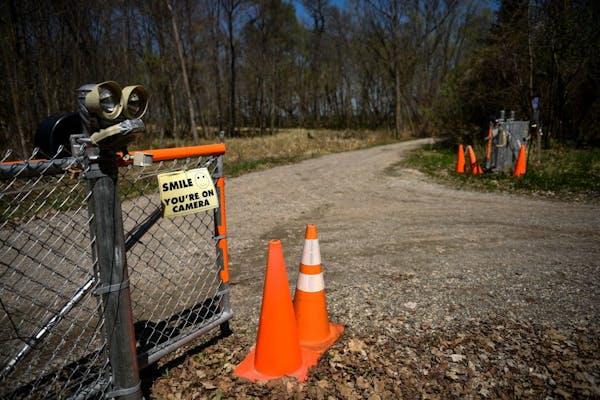KNIFE RIVER, Minn. – In a bobbing, 4-foot sea on Lake Superior, Josh Blankenheim stretched well beyond the front railing of Blackfin, the DNR's work boat, to grab a tall buoy attached to a fishing net.
Within seconds of wrestling the instrument aboard, the vessel's motorized net puller revved loudly to retrieve a seine loaded with fat lake trout, 143 feet under. Blankenheim and two fellow biologists picked fish out of the net as fast as they could, heaving them into coded tubs to indicate location of catch.
"This is pretty amazing right here,'' said Chris Palvere, the boat's captain. "We're seeing a lot of fish.''
Big, too. The net was rigged to catch fish ranging from 4 to 10 pounds, and plenty were longer than 2 feet. Over the course of more than three hours, the crew gathered 103 lake trout from three nets set in frigid, pristine water.
As another summer begins in Minnesota, North Shore fishing villages, local charter boat captains and individual anglers willing to launch into the oftentimes sudden-changing waters of Gitche Gumee are enjoying a lake trout revival of epic proportions. The turnaround — 50 years in the making — was capped less than a year ago when the Department of Natural Resources fully reopened the native species to commercial fishing.
"It's a great success story … and it's completely sustainable,'' said Steve Dahl, one of two commercial fishermen permitted to take 250 lake trout a year from "MN-1" — the Duluth-area fishing zone heavily fished by sport anglers.
So healthy is the wild lake trout fishery from Duluth to Grand Portage that catching a stocked lake trout has become uncommon. Those supplemental fish were critical to keeping the species alive after exploitation and invasive sea lamprey devastated "lakers'' from eastern Lake Erie to Isle Royale.
Natural reproduction of the char family fish has recovered so well in Lake Superior that Minnesota completely halted its stocking program in 2015. In a recent haul made by the DNR for one of its annual studies, 93 percent of the catch was wild.
Now the DNR believes it would do more harm than good to manipulate the system with stocking or protective slot regulations. Licensed anglers are now free to possess three lake trout of any size.
"We restored the top predator fish [in the Minnesota waters of Lake Superior] and people are barely noticing,'' Minnesota fisheries chief Don Pereira said.
When he retires next week, Pereira will count the revival as one of the top fish-management accomplishments of his era — achieved with cooperation from Canada, tribal authorities and states around the Great Lakes. If you're one of more than a million Minnesota residents a year who buys a state fishing license, your proceeds helped the cause.
"You hardly ever lose a top predator and get it back,'' said Cory Goldsworthy, DNR Lake Superior fisheries supervisor.
According to a DNR report issued last month, the overall lake trout catch rate in last year's spring assessment was 15.3 fish per 1,000 feet of net, an upward trend that appears to be gaining trajectory. In the northernmost zone known as "MN-3,'' last year's rate was the highest ever: 35 fish per 1,000 feet of net, the report said.
That compares to only two or three lake trout per 10,000 feet of net during the fishery's full collapse in the early 1960s. Now the lake trout bite on Lake Superior has gotten so good that experienced recreational anglers can typically catch their personal limit in a couple of hours of trolling or jigging from family fishing boats, Goldsworthy said. Two Harbors and the McQuade Small Craft Harbor in Duluth are popular launching spots.
Thin deep line
Minnesota controls only 7 percent of Lake Superior, and most of that territory is too deep to support lake trout. Their habitat stretches in a thin ribbon close to shore, but it amounts to hundreds and hundreds of square miles of fishable water.
Dahl said it didn't take long for him to find a few sweet spots to set his nets. When the commercial season opens June 1, he will pace himself to spread his harvest into the fall. His catch is "wild caught,'' "organic,'' and "local'' — categories that create great demand. But the 250 fish he is allowed to take each season are gobbled up on the North Shore before they ever reach the Twin Cities.
"There are so many trout that I basically set only once a week,'' he said. "It's extremely sustainable on the commercial side.''
In the two fishing zones north of the greater Duluth area (MN-2 and MN-3), DNR officials reopened commercial fishing a few years ago. Those areas were deemed safer to exploit with seine nets because sport fishing pressure is markedly lower.
Still, the total commercial lake trout harvest on Lake Superior was only 4.000 fish last year, compared to 2017's recreational harvest of 28,000.
Steady as she goes
Fast-changing lake conditions are an ally to lake trout when it comes to fishing — a truism evident during the DNR's assessment work. Consider the "garden,'' a reliable lake trout lair a few miles northeast of Knife River. It was named by local charter boat captains.
"If they're not having luck elsewhere, they'll say, 'Let's go pick the garden,' '' said Palvere, the DNR skipper.
The garden's surface water temperature was 36 degrees when Palvere steered to it on a recent Tuesday morning. The Knife River area was under a small craft advisory and Palvere, Goldsworthy, Blankenheim and DNR biologist Keith Reeves were in a hurry to pick all the lake trout they could before conditions worsened.
The lake cooperated while the crew emptied a net at the Garden and one at Stoney Point. But as they approached the third net at Bluebird Landing, Goldsworthy asked Palvere if he could still safely control the boat. Palvere gave a thumbs up, then fought wind and waves to keep the boat in line.
A loose lake trout flopped at his feet. On the work deck of the 31-foot Blackfin, the crew braced themselves against the gunwales, constantly sprayed by crashing waves in what was now a 5- or 6-foot sea. As soon as the final net was packed away, Palvere eased the boat back to the marina at slow speed.
"This is about as bad as we'll go out,'' he said.
Hot dog data
Especially in the spring of the year, Lake Superior lake trout prey on plentiful rainbow smelt. Shaped like little hot dogs, the smelt are so identifiable in the bellies of lake trout that DNR biologists measure and weigh each prey fish as part of their data collection. One 26-inch lake trout contained 10 whole smelt.
In other aspects of the "work-ups,'' the trout are aged, weighed, identified by gender and measured in length. The agency is finding reliable evidence that young lake trout are surviving in stable numbers and can expect to live into their 30s and 40s.
More importantly, lake trout are escaping mortality from sea lamprey. The DNR originated its spring netting assessment decades ago to count circular sores left by the vampire-like invaders. Once found on more than 80 percent of lake trout, the collective wounding rate for North Shore lake trout now sits just below 5 percent.
Still, Goldsworthy said the lamprey pose a never-ending threat.
Since the 1950s, two pesticides applied to lamprey spawning areas throughout the Great Lakes have proved effective at greatly reducing fish mortality. But lamprey populations still flare up in various regions and fish are at the mercy of intermittent lampricide applications funded and scheduled by the U.S. Fish & Wildlife Service and Fisheries and Oceans Canada.
Keeping focused
For the sake of lake trout and overall fishery health, the DNR's management strategy going forward is for a natural ecosystem approach that pays less attention to the stocking of coho salmon, chinook salmon and other unnatural species introduced in past decades — dating to the 1880s — for the benefit of sport fishing. Last year, for example, the agency dumped a sport fishing program that stocked the lake with Kamloops rainbow trout.
Fish introduced to the lake have competed against lake trout for prey and one of the enduring fears is that Superior's prey base is thinning. Pereira said biologists are intently studying the lake's food web and the conclusions will play into future trout fishing regulations.
Pereira, Goldsworthy and others also harbor fears of climate change and new invasive species — an interrelated threat. Since 1970, 39 new non-indigenous aquatic organisms have entered Lake Superior. Among them were nine fish species, seven aquatic invertebrates, eight fish diseases and parasites. The St. Louis Harbor in Duluth and Superior, Wis., remains the busiest inland port in the U.S., with more than 1,000 vessel trips annually.
The DNR also worries that if contaminant levels in lake trout increase, the agency could lose public support for fostering the species. Current advisories say lake trout less than 22 inches can be safely eaten once per week, while 22-37-inch lakers should be eaten once per month, and those greater than 37 inch, one every two months.
But for now, lake trout rehabilitation in Lake Superior is acclaimed. The story will be told in July at an international fish management symposium in Duluth.
Said Goldsworthy, "Now we are in a more natural state [with lake trout] than we've been in 100 years.''
Tuesday's prep sports results
Kawhi Leonard returns to the Clippers' lineup for Game 2 against Luka Doncic and the Mavericks
Pavin Smith hits grand slam and drives in 6 runs as Diamondbacks rout Cardinals 14-1

